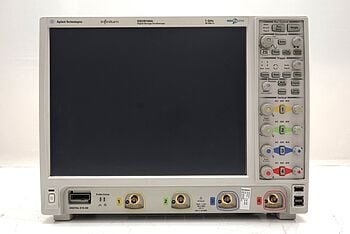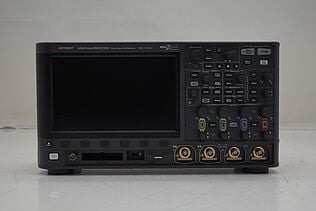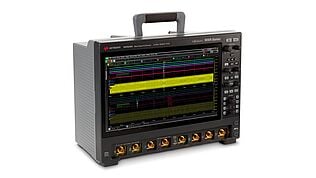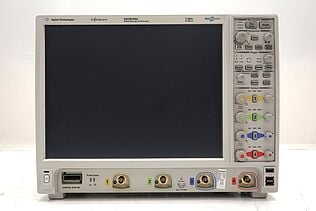- Introduction
- Understanding Digital Sampling Oscilloscopes
- Key Components of a DSO
- How DSOs Work
- Analog Signal Conditioning
- Sampling and Digitization
- Storing and Processing
- Display and Analysis
- Advantages of Digital Sampling Oscilloscopes
- Superior Signal Resolution
- Advanced Functionality
- Flexibility and Usability
- Common Applications
- Signal Integrity Analysis
- Digital Communications Testing
- Semiconductor Testing
- Key Specifications to Consider
- Tips for Using a Digital Sampling Oscilloscope
- Conclusion
- Whenever You’re Ready, Here Are 5 Ways We Can Help You
What if you could freeze time to examine the tiniest details of a rapidly changing signal? This isn’t just science fiction; it’s the everyday reality when using a digital sampling oscilloscope (DSO).
DSOs allow you to capture and analyze high-speed electronic signals with incredible precision.
Whether you're debugging a circuit or designing cutting-edge technology, these oscilloscopes allow you to see what’s really happening in your electrical signals.
In this article, we will explore how DSOs provide the clarity you need to master complex electronic challenges.
Understanding Digital Sampling Oscilloscopes
Digital sampling oscilloscopes are essential tools for observing and measuring electronic signals, particularly those with high-frequency or fast transient events.
Unlike traditional analog oscilloscopes, DSOs digitize the incoming signal and store it for analysis. This digital approach allows for greater detail and advanced functionalities, making them an essential component in modern electronics testing and development.
| Key Takeaway |
|---|
| Digital sampling oscilloscopes are essential for modern electronics testing, offering high-speed signal capture and detailed analysis capabilities. Their ability to accurately digitize, store, and process signals allows you to troubleshoot and optimize complex electronic systems. |
Key Components of a DSO
- Analog front-end: Conditions the incoming signal for sampling.
- Analog-to-digital converter (ADC): Converts the conditioned analog signal into a digital format.
- Memory: Stores the digitized signal for processing and display.
- Digital processing unit: Handles signal processing, including filtering, scaling, and waveform reconstruction.
- Display: Shows the processed signal, allowing for visual analysis.
Explore Keysight’s Range of Oscilloscopes Today
How DSOs Work
To understand how DSOs work, think of them as highly advanced cameras for electrical signals, capturing snapshots in rapid succession to create a detailed picture of fast-moving waveforms.
Here’s a breakdown of their key operational stages.
Analog Signal Conditioning
Before a signal can be digitized, it must be prepared to fit within the ADC’s range. This preparation ensures accurate digitization and involves several steps.
- Attenuation: High-voltage signals are reduced to safer levels suitable for the ADC.
- Amplification: Low-voltage signals are boosted to ensure they are within a measurable range.
- Filtering: Unwanted frequencies or noise are removed to clean the signal for accurate analysis.
Sampling and Digitization
The ADC is crucial to a DSO, converting the analog signal into a digital format.
- Sampling: The ADC captures the signal’s amplitude at discrete intervals, determined by the sampling rate.
- Quantization: Each sampled value is rounded to the nearest available digital level, translating continuous signal variations into distinct digital steps.
- Encoding: These values are then transformed into binary code, making them ready for digital processing.
Key Factors in Sampling
- Sampling rate: Indicates how frequently the signal is sampled per second. Higher sampling rates result in more detailed signal representation.
- Bit depth: Refers to the number of bits used to represent each sample, influencing the resolution and accuracy of the amplitude measurements.
Storing and Processing
The digitized signal is then stored in the DSO’s memory, allowing for extensive processing and analysis:
- Waveform averaging: Combines multiple signal acquisitions to reduce noise and improve the signal-to-noise ratio.
- FFT (Fast Fourier Transform): Transforms the time-domain signal into its frequency components, facilitating spectral analysis.
- Other Mathematical operations: Enables various calculations, such as differentiation or integration, to further analyze the signal’s characteristics.
Display and Analysis
After processing, the signal is reconstructed and shown on the oscilloscope’s display, where you can analyze it using different modes.
- Real-time display: Continuously shows the signal as it is being captured, useful for live monitoring.
- Persistence mode: Displays accumulated signal data over time, helping visualize variations and patterns.
- Zoom and pan: Allows you to focus on specific parts of the signal for detailed examination.

Advantages of Digital Sampling Oscilloscopes
DSOs offer a range of benefits that make them indispensable in modern electronic testing and design. Their ability to capture, store, and analyze signals with high accuracy transforms how engineers approach troubleshooting and development.
Superior Signal Resolution
DSOs excel in capturing and reproducing high-fidelity signal details.
- High sampling rates: DSOs can sample signals at incredibly high rates, allowing you to observe rapid signal changes and transient events with exceptional precision. This capability is crucial for analyzing fast digital signals and intricate analog waveforms.
- Enhanced bit depth: With greater bit depth, DSOs offer a finer granularity in amplitude measurements, allowing for more accurate representation of signal variations. This is essential for detecting subtle differences in signal behavior.
Advanced Functionality
DSOs come with a suite of advanced features that extend their utility beyond simple signal visualization.
- Triggering options: DSOs provide sophisticated triggering mechanisms that allow you to capture specific events within a signal. These options can include edge, pulse width, and pattern triggering, helping you isolate and analyze complex signal behaviors.
- Post-processing capabilities: After capturing the signal, DSOs can perform various calculations and adjustments. This includes mathematical functions, filtering, and signal transformations, enabling detailed analysis directly on the device.
- Storage and playback: DSOs can store captured waveforms, enabling you to save and later recall data for further analysis or comparison. This feature is invaluable for long-term monitoring and diagnostics.
Flexibility and Usability
Modern DSOs are designed with the user in mind, providing features that improve usability and flexibility.
- User-friendly interface: DSOs often feature intuitive interfaces with touchscreen controls, customizable displays, and easy-to-navigate menus. This user-centric design makes it easier for you to set up measurements, adjust settings, and analyze data efficiently.
- Remote operation: Many DSOs support remote operation, allowing you to control the oscilloscope and access data over a network. This functionality is particularly useful for applications requiring remote monitoring or where physical access to the device is limited.
The advanced capabilities of DSOs, from their superior resolution to their versatile functionality and ease of use, make them essential tools for any engineer working with complex electronic signals.
Whether you're capturing high-speed transients or performing detailed signal analysis, DSOs provide the tools you need to get the job done effectively.
Common Applications
DSOs are versatile tools used across various fields of electronics and communication. Their ability to precisely capture and analyze fast-changing signals makes them invaluable for a range of applications where accuracy and detail are paramount.
Signal Integrity Analysis
In high-speed circuits, maintaining signal integrity is crucial. DSOs play a key role in:
- Timing analysis: Help you measure and verify the timing relationships between signals, ensuring that all components in a high-speed circuit operate in sync.
- Noise analysis: They allow you to identify and analyze noise sources that can affect signal fidelity, such as crosstalk and electromagnetic interference (EMI).
- Jitter measurement: By quantifying jitter, DSOs help you assess the stability of signal timing, which is vital for the performance of high-speed data and clock signals.
Digital Communications Testing
DSOs are essential in testing and optimizing communication systems:
- Jitter analysis: Can measure jitter to evaluate how much timing variation exists in a signal, which is critical for maintaining data integrity in digital communications.
- Bit error rate testing: They enable the analysis of bit error rates (BER), helping you determine the efficiency of data transmission and identify any loss or corruption in the data stream.
- Modulation analysis: Can also analyze various modulation schemes used in digital communications, providing insights into the signal’s performance and robustness.
Semiconductor Testing
For semiconductor devices, DSOs provide detailed insights into their behavior and performance:
- Transient response characterization: Capture the fast transient responses of semiconductor devices, helping you evaluate their performance under different operating conditions.
- Compliance testing: They are used to verify that semiconductor devices meet design specifications and industry standards, ensuring reliability and functionality.
- Failure analysis: In the event of a device failure, DSOs help you analyze and understand the root causes by providing detailed waveform data that reflects the device's behavior at the moment of failure.
Key Specifications to Consider
When selecting a DSO, consider the following specifications:
| Specification | Description |
| Bandwidth | Determines the frequency range the oscilloscope can accurately measure. |
| Sampling Rate | Defines how often the signal is sampled. Higher rates capture more detail. |
| Memory Depth | Affects how much data can be stored for analysis. Deeper memory enables more detailed observation over time. |
| Vertical Resolution | Indicates the precision of amplitude measurements, usually in bits. |
| Triggering Options | Specifies the types of events that can start data acquisition. |
| Connectivity | Includes interfaces like USB, Ethernet, and GPIB for data transfer and remote control. |
Tips for Using a Digital Sampling Oscilloscope
- Select the appropriate bandwidth: Ensure the oscilloscope's bandwidth matches or exceeds the highest frequency component of your signal.
- Optimize sampling rate: Use a sampling rate at least 2.5 times higher than the signal’s maximum frequency to avoid aliasing.
- Adjust vertical scale: Set the vertical scale to capture the full amplitude range of the signal for accurate measurement.
- Use proper probes: Match probes to the oscilloscope's bandwidth to minimize signal distortion.
- Leverage triggering options: Use advanced triggering features to isolate specific events in complex signals.
Maximize Your Budget with Keysight's Refurbished Oscilloscopes
Select up to 3 instruments to compare
Enable Notifications
In order to use this feature, you need to enable notifications.
Manage notification preferences
Conclusion
Digital sampling oscilloscopes provide unmatched precision in capturing and analyzing high-speed electronic signals.
With their superior signal resolution, advanced functionality, and user-friendly features, they are crucial for applications ranging from signal integrity analysis in digital communications to semiconductor testing.
They allow detailed measurement, sophisticated analysis, and convenient data handling, making them indispensable tools for modern electronics professionals.
If you’re looking to improve your testing capabilities with reliable and high-performance equipment, visit the Keysight Used Equipment Store for premium used DSOs, spectrum analyzers, function generators, and multimeters. Get quality instruments at a great value to meet your testing needs.

Whenever You’re Ready, Here Are 5 Ways We Can Help You
- Browse our Premium Used Oscilloscopes.
- Call tech support US: +1 800 829-4444
Press #, then 2. Hours: 7 am – 5 pm MT, Mon– Fri - Talk to our sales support team by clicking the icon (bottom right corner) on every offer page
- Create an account to get price alerts and access to exclusive waitlists.
- Talk to your account manager about your specific needs.












































